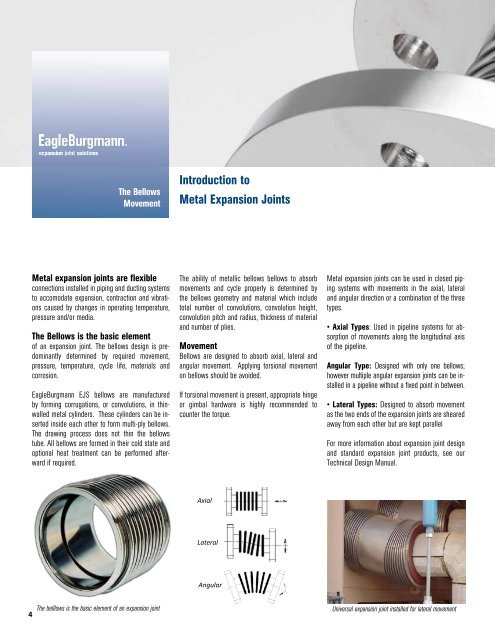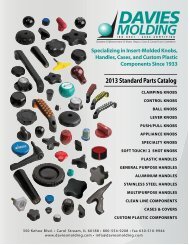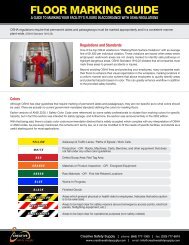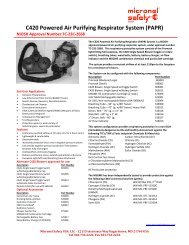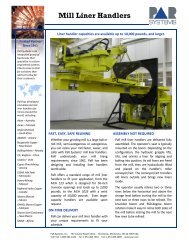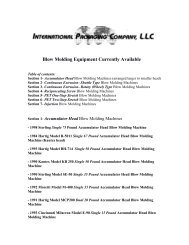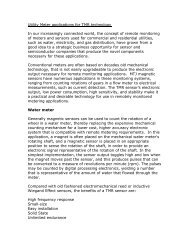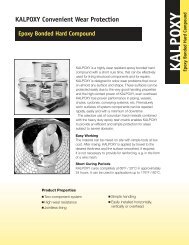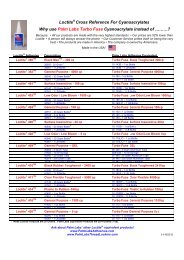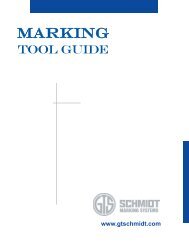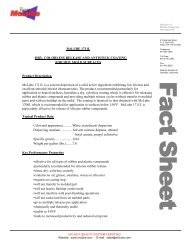Metal Expansion Joints - ThomasNet
Metal Expansion Joints - ThomasNet
Metal Expansion Joints - ThomasNet
You also want an ePaper? Increase the reach of your titles
YUMPU automatically turns print PDFs into web optimized ePapers that Google loves.
The Bellows<br />
Movement<br />
<strong>Metal</strong> expansion joints are flexible<br />
connections installed in piping and ducting systems<br />
to accomodate expansion, contraction and vibrations<br />
caused by changes in operating temperature,<br />
pressure and/or media.<br />
The Bellows is the basic element<br />
of an expansion joint. The bellows design is predominantly<br />
determined by required movement,<br />
pressure, temperature, cycle life, materials and<br />
corrosion.<br />
EagleBurgmann EJS bellows are manufactured<br />
by forming corrugations, or convolutions, in thinwalled<br />
metal cylinders. These cylinders can be inserted<br />
inside each other to form multi-ply bellows.<br />
The drawing process does not thin the bellows<br />
tube. All bellows are formed in their cold state and<br />
optional heat treatment can be performed afterward<br />
if required.<br />
Introduction to<br />
<strong>Metal</strong> <strong>Expansion</strong> <strong>Joints</strong><br />
The ability of metallic bellows bellows to absorb<br />
movements and cycle properly is determined by<br />
the bellows geometry and material which include<br />
total number of convolutions, convolution height,<br />
convolution pitch and radius, thickness of material<br />
and number of plies.<br />
Movement<br />
Bellows are designed to absorb axial, lateral and<br />
angular movement. Applying torsional movement<br />
on bellows should be avoided.<br />
If torsional movement is present, appropriate hinge<br />
or gimbal hardware is highly recommended to<br />
counter the torque.<br />
Axial<br />
Lateral<br />
Angular<br />
<strong>Metal</strong> expansion joints can be used in closed piping<br />
systems with movements in the axial, lateral<br />
and angular direction or a combination of the three<br />
types.<br />
• Axial Types: Used in pipeline systems for absorption<br />
of movements along the longitudinal axis<br />
of the pipeline.<br />
Angular Type: Designed with only one bellows;<br />
however multiple angular expansion joints can be installed<br />
in a pipeline without a fixed point in between.<br />
• Lateral Types: Designed to absorb movement<br />
as the two ends of the expansion joints are sheared<br />
away from each other but are kept parallel<br />
For more information about expansion joint design<br />
and standard expansion joint products, see our<br />
Technical Design Manual.<br />
The belllows is the basic element of an expansion joint Universal expansion joint installed for lateral movement<br />
4


